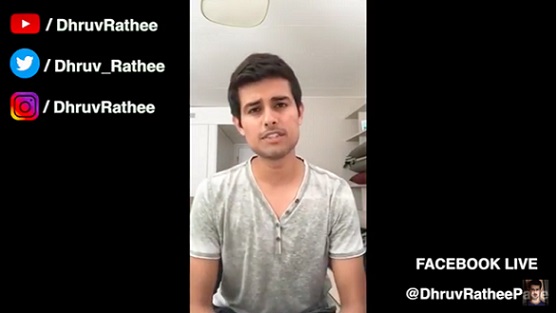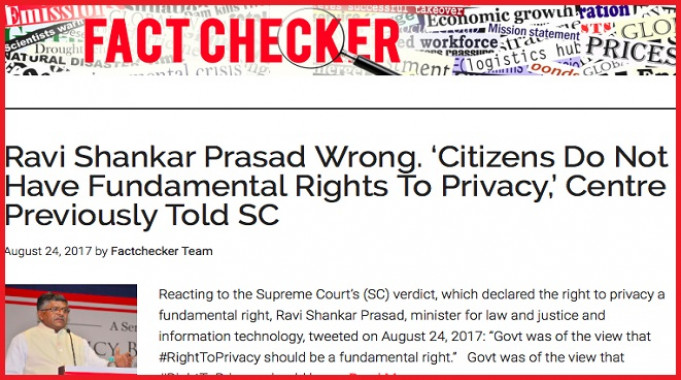Calling out lying politicians
On August 17, a video was going around like wildfire on WhatsApp. It wasn’t a fake video as viral WhatsApp videos often tend to be. Instead, it was one which pointed to baffling contradictions in the government’s data on the rise in the number of new tax payers this year. The YouTube video, which has garnered more than one lakh views, shows a young man who looks like a college sophomore referring to the Prime Minister’s Independence Day speech and calling out the NDA government for its conflicting figures regarding the so-called tax surge after the currency ban.
Speaking in homespun, everyday Hindi, Dhruv Rathee walks his audience through four sets of data put out by the government: the Prime Minister’s Independence Day speech which stated that there were 56 lakh new taxpayers; Finance Minister Arun Jaitley’s statement on May 1 put the figure at 91 lakh; the government’s written reply in the Rajya Sabha earlier this month pegging it at 33 lakh; and finally, the Economic Survey, overseen by Chief Economic Advisor Arvind Subramaniam which stated that the number of new taxpayers after demonetisation stood at 5.4 lakh.
“Koi toh jhoot bol rahe hai in mein sey,” says Rathee, whose Twitter bio describes him as a “Youtuber, Educator, Political & Social Activist, Environmentalist, Renewable Energy Engineer, Traveller and a Vegetarian”. He is, in other words, a private citizen, who is using social media to question data that seem inconsistent or gussied up.
Rathee did not get into the minutiae or the rigour of actually checking the government’s statements to see whether they were authentic or not. Nor did he try to figure out where - and if - the stats had been cooked. But James Wilson does just that. A civil engineer who works with the State Water Advisory Committee of Kerala, Wilson became a social media celebrity late last year after he began to dissect the government’s cheery assertions regarding the note ban. Since then, he has fact-checked many a claim by the government on his blog “Decipher the demonetisation”.

Wilson, like Rathee, is part of a small, but growing tribe of fact-checkers in India who are keeping a zealous eye out for fake news in general and dubious claims by the government in particular. With the bulk of the mainstream media gratefully reproducing any data put out by the government, it has fallen to feisty fact-checking websites such as Altnews.in, SM Hoax Slayer, Boom or FactChecker.in — most of them set up in the last two years — and a few citizens like Wilson or Rathi to expose the lie and highlight the discrepancies and the tall claims.
In a blog post on August 14 this year, Wilson does the same with the government’s shifting statements on the rise in the number of new taxpayers post the currency ban. His conclusion: “So all these hard data from the CAG, CBDT and MoF proves that there was no substantial increase in the number of new taxpayers or direct tax collection due to demonetisation.”
You may or may not agree with Wilson’s methodology or his detailed and painstaking analysis of data drawn from the government’s own websites and press releases that are in the public domain. But there is no denying that he and others of his ilk are raising pertinent questions regarding the roseate data that the government often presents to the public.
After the multiplicity of new taxpayer figures became the latest joke on social media, the government issued a statement on August 18, saying that there were, in fact, no discrepancies at all and that each data set adhered to a different context and time period.
It said, first, that between April 1 and August 5, 2017, 2.79 crore e-returns were received as against 2.23 crore received during the same period last year. This checks in with the PM’s statement that there were 56 lakh new taxpayers - a rise of 24 per cent over the previous year.
Second, that the Finance Minister’s figure of 91 lakh new taxpayers referred to the entire financial year of 2016-17.
Third, that the Economic Survey’s figure of 5.4 lakh was for the period between November 9, 2016 (the day after demonetisation) to March 2017.
And fourth, that the figure of 33 lakh new taxpayers given in the Rajya Sabha was flawed as it was derived from “incomplete” information.
The very next day, Wilson did a blog post examining the new set of references and punching holes in the government’s basic contention that the currency ban had translated into a huge bonanza in terms of tax collection.
Citing the annual report of the Finance Ministry (FY 2015-16) on the growth of e-filing of tax returns, Wilson demonstrates that a 24 per cent rise is hardly as stunning as it is being made out to be. The government’s own data showed that equal or more increases occurred several times in the past: the rise in e-returns was 27.2% in 2015-16, 38.6% in 2013-14 and 79% in 2011-12.
He also points out that though the Central Board of Direct Taxes was now saying that the Finance Minister’s version of 91 lakh new taxpayers referred to the entire financial year of 2016-2017, back in May when Jaitley made the statement, every news media had reported that he was speaking about the number of new taxpayers who had come into the system post-demonetisation.
Truth Vs Hype, a show on NDTV, also fact-checked the government’s so-called clarification. Among other things, anchor Sreenivasan Jain pointed out that the 91 lakh figure did not tally with the government’s own Economic Survey report which said that there had been an addition of 80.7 lakh new taxpayers during FY 2016-17.
While the inconsistencies remained, it seemed that the government had cherry-picked data to create the perception that the currency ban and “operation clean money” had been a resounding success.
This year, the Prime Minister’s Independence Day speech was subjected to a detailed fact check as well. FactChecker.in examined the part where the PM highlighted the achievements of his government and found that while many of his statements, such as those relating to rural electrification, the attaching of unauthorised transactions or the number of Jan Dhan Yojana accounts opened, were true, some were only partially true.
For example, Modi’s assertion that 175,000 shell companies had been shut after the currency ban was partly correct. The actual figure is 162,618.
In a welcome move, the Fact Checker report on the PM’s Independence Day speech was carried by some members of the mainstream media such as Hindustan Times, Business Standard and so on. The move was welcome because, unlike in the US, where the mainstream media plays a proactive role in calling out dodgy facts, especially those trumpeted by President Donald Trump, fact-checks in India have become almost the exclusive preserve of dedicated websites, a few vigilant citizens and some intrepid news portals such as The Wire or Scroll.in.
This week a report in The Wire fact-checked Jaitley’s recent assertion that demonetisation had left the insurgents in Kashmir and the Maoists in Chhattisgarh starved of funds, leading to a significant decline in violence in these areas.
Quoting data from South Asia Terrorism Portal and sundry media reports, it concluded that this was far from the truth. “Between November 9, 2016 and August 13, 2017, data shows that there have been 93 incidents leading to deaths in Kashmir, including security forces, militants and civilians. During the same time period in the preceding year (November 9, 2015 to August 13, 2016) there had been 70 such incidents,” the report said.
It also said: “When it comes to the insurgency in Chhattisgarh, in the post-demonetisation period between November 10, 2016, and August 13, 2017, the number of encounters that have led to deaths - of civilians, security forces or Maoists - is 60. In the same time period in the preceding year, the number stood at 65.”
Several claims made by the government in recent months have, in fact, been exposed as dubious, exaggerated or plain false. On Friday, FactChecker.in reported that Home Minister Rajnath Singh’s statement on August 20 that the National Investigation Agency’s efforts had led to a 40% decline in terrorism in Naxal areas in the last three years was untrue. The correct figure was a 4% decline, it said.
Or take BJPForIndia’s triumphant tweet in May this year that India had jumped 16 places from 40 to 24 in the UN World Tourism Organization (UNWTO) rankings. An impressive statistic that implies a huge upturn in the tourism industry, right?
Wrong. Altnews’s fact check on this revealed that the new rankings for the years 2014 and 2015 were arrived at by the simple expedient of including the arrival of NRIs into the pool of International Tourist Arrivals (ITA) on which the UNWTO rankings are based. Hence, with the addition of 5.43 million NRI arrivals in 2014 and another 5.26 million in 2015, the number of ITAs in 2014 and 2015 became 13.11 million and 13.28 million respectively.
The NRI inclusion wasn’t out of line as the UNWTO recognises the arrival of Non-Resident Nationals to be part of International Tourist Arrivals in a country. However, to project the step-up in the rankings as though it were a metric of the government’s performance does amount to a nimble bit of data management.
Indeed, whether it is dodgy stats, wild assertions, or photoshopped images, the country’s handful of fact-checkers have been quick to expose them. Power Minister Piyush Goyal got a taste of that this week when he tweeted: “Govt has illuminated 50,000Km of Indian roads by retrofitting 30 lakh conventional street lights with LED lights”.
Unfortunately, the picture he or his department used with the tweet was one which was at least eight years old and of unknown provenance.
SM Hoax Slayer, probably the first to point out the fake picture, tweeted in response: “Great work sir. But a small request - when it's already done, pls use real photos. This is decades old used by many manufacturers & countries”.
Altnews went on to report that the picture dated from at least 2009 and was used on the CNET website as part of an article about a partnership between LED start-up Luminus and a Japanese firm.
A chastened Goyal later deleted the tweet, thanking people on Twitter for pointing out the error. “While we illuminate streets, social media helps illuminate facts, helping us improve,” he tweeted.
The fact-checkers are doing just that - helping to illuminate the real facts and making citizens aware of them. Whether or not they can help the government “improve” remains to be seen.
Shuma Raha is an independent journalist based in Delhi.







